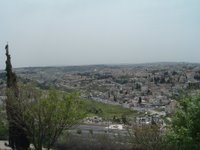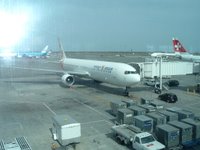Holy Land Day 8
This was the day I was seeking the entire week. Throughout the week it was hard – churches built to remember events seemed to desecrate them in my mind. Finally, peace.
I wrote the following to LeeAnn Saturday morning.
============
“My angel, I found what I was looking for. We went to the Garden Tomb, a place of remembrance. The English purchsed the property in the 1800s and give a theory why they believe it could be the site of the crucifixion and tomb.I felt moved. We had communion! I found myself with tears. I found Peace this morning. I am sad I am leaving, because there is so much here. But, I miss my family, all of you. I want to return, I want to study, but most of all I want to share this trip and future trips with you.I feel peace.J”
============
That summed it up the best. We left the hotel and went to the Garden Tomb about 9am. The Garden Tomb is an area that the english bought and set aside to remember Christ’s crucifixion. About 1000 people a day visit the site and it is guarded outside by Israeli soldiers (just two). It is what you would imagine, a beautiful garden. There is a rock wall, “skull mountain” that remembers the men crucified there by the romans. the face of the rock itself resembles a skull and the skulls from those crucified were thrown into a pit.
The English that own this site believe this is a possible place, instead of Mt. Calvary, because of the rock, the roads intersecting there and Roman tradition to crucify by the road, and that there is a tomb located nearby. Regardless, they state tha this is a hypothesis, like anything else in Jerusalem and should be remembered as such. The place is very peaceful. We spent about an hour there and it was completed with communion. If nothing else, our communion was a time to reflect on our trip and what had happened this week.
After the Garden Tomb, we traveled to West Jerusalem. It was beautiful. The city changed from the rundown side we had seen in East Jerusalem, primarily occupied by the Palestinians, to the Jewish dominated part of town. We saw the church that remembers the site where John the Baptist was born, and we saw the wilderness where he preached.
Next, we climbed a hill up to a church to remember the site of the Visitation – where Mary told Elizabeth that she would be preagnant with the Son of God.
That was it — a short day followed by an afternoon of killing time waiting to leave. We flew out of Tel-Aviv at 12:20a, flew 12 hours, and arrived New York at 5:35a. If you do the math, I had almost 18 hours of darkeness as the aircraft stayed just ahead of the sun.
Would I go again – YES! I want to share the Holy Land with LeeAnn and the kids. I think it would be a great gift to all of them as studying the bible will never be the same. I understand what it means to “go up to Jerusalem”, what the wilderness looked like, and where the Golan Heights are. I can remember the geography and picture that in my mind when reading and studying the bible. The churches are beautiful, and I can accept them for their uniqueness and a way to remember miracles or very important events that took place in the Bible. I understand that is there purpose and each religions’ way of remembering those events.
My own journey was to learn. I am very naive when it comes to studying the bible, or even understanding the history of man in any of these locations. I learned history, saw archaeology, and hopefully understand more about today’s politics in the area.
I would tell you to go go go on such a trip. I went with an organized tour group and was also able to enjoy it from the cohesiveness of our group, all being from the same church. There is much to learn.
Please feel free to email me with questions. I am going to post all of this on my blog





Recent Comments